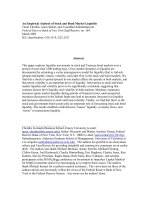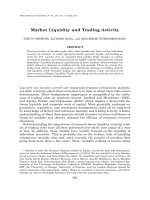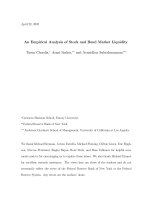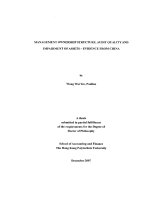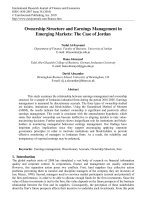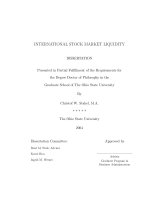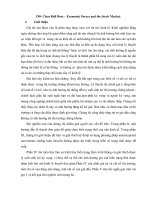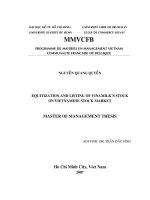Ownership structure and stock market liquidity
Bạn đang xem bản rút gọn của tài liệu. Xem và tải ngay bản đầy đủ của tài liệu tại đây (573.93 KB, 19 trang )
Int. J. Managerial and Financial Accounting, Vol. 3, No. 1, 2011
Ownership structure and stock market liquidity:
evidence from Tunisia
Nadia Belkhir Boujelbéne* and
Abdelfatteh Bouri
Research Unit Corporate Finance Financial Theory – COFFIT,
Faculty of Economics Sciences and Management,
University of Sfax, 3018 Sfax, Tunisia
E-mail:
E-mail:
*Corresponding author
Jean-Luc Prigent
Research Unit THéorie Economique, Modélisation et Applications –
THEMA, University of Cergy,
Pontoise. 33, boulevard du Port,
F-95011 Cergy-Pontoise Cedex, France
E-mail:
Abstract: The aim of this paper is to identify and analyse the influence
of ownership concentration on stock market liquidity in general, and the
adverse selection component of the spread in particular for a panel of Tunisian
firms from 2001 to 2007. We document that firms with greater insider
ownership display significantly lower liquidity. The negative relation between
liquidity and insider ownership is attributable to adverse selection. We also find
that the only negative correlation between blockholders and liquidity persists is
that with turnover. Thus, it appears that blockholders decrease liquidity. We
find that ownership effect depends on the owner identity. Our results suggest
that state ownership is negatively related to spread, and positively related to
market depth. Foreign ownership has no significant effect on liquidity
measures.
Keywords: insider ownership; INSID; institutional ownership; INST; foreign
ownership; FORG; state ownership; STATE; liquidity; bid-ask spread; depth;
turnover; price impact; PIMP; adverse selection costs; Tunisia.
Reference to this paper should be made as follows: Boujelbéne, N.B.,
Bouri, A. and Prigent, J-L. (2011) ‘Ownership structure and stock market
liquidity: evidence from Tunisia’, Int. J. Managerial and Financial Accounting,
Vol. 3, No. 1, pp.91–109.
Biographical notes: Nadia Belkhir Boujelbéne is a PhD student in Corporate
Finance Financial Theory (COFFIT) at the University of Economics and
Management in Sfax-Tunisia.
Abdelfatteh Bouri is a Professor in Corporate Finance Financial Theory
(COFFIT) at the University of Economics and Management in Sfax-Tunisia.
Jean-Luc Prigent is a Professor in Théorie Economique, Modélisation
et Applications (THEMA) at the University of Cergy, Pontoise.
Copyright © 2011 Inderscience Enterprises Ltd.
91
92
1
N.B. Boujelbéne et al.
Introduction
Stock market liquidity is one of the fundamental components of market microstructure
and has been viewed as an issue of interest in the financial literature. The adverse
selection component of bid-ask spreads, which is due to information asymmetry between
dealers and informed traders, is well founded in the financial literature. A fundamental
objective of the present study is to explore how ownership level affects the stock market
liquidity and the adverse selection component in emerging stocks markets. This study has
three distinct features that differentiate it from existing studies. First, we enlarge the
market-level database from emerging market economies. Second, we gather transaction
data from pure order driven market, while previous studies are collected transaction data
from quote-driven markets. The third feature of our study is that we introduce a set of
better measures of liquidity such as quoted spread, effective spread, market depth,
turnover, and price impact (PIMP).
Tunisia corresponds to an ideal setting to examine these issues. In fact, Tunisian
listed companies have similar ownership characteristics to publicly traded companies
in most countries around the world. They are characterised by a high degree of
ownership in general and are predominantly family-controlled. The Tunisian Financial
system is fragmented, dominated by banks. Besides, financial institutions, including
insurance, investment and securities companies own important proportions of the shares
in listed companies and are often among the five largest block holders. The main
characteristic of ownership is that it is highly concentrated. According to the study of
Omri (2001), the percentage of shares held by top five shareholders, in Tunisia, should
exceed 88%.
A lot of theoretical studies argue that the market liquidity will facilitate the exit
of large shareholders and thus reduce the intervention from those shareholders
(Bolton and Thadden, 1998). Holmström and Tirole (1993) derive a theoretical model
for investigating the negative relationship between ownership concentration and
market liquidity. The model suggests that the liquidity increased when the ownership
by a large owner decreased. However, Maug (1998) and Kahn and Winton (1998)
argue that the large shareholders tend to increase their holdings in a more liquid stock
market.
Previous studies are instigated for developed capital markets, those are quote-driven
markets and most liquid in the world as the USA (Brockman et al. 2009; Rubin,
2007; Heflin and Shaw, 2000), where the institutional environments differ greatly
from that in Tunisia. It is well identified that emerging financial markets are not as
liquid as those of developed economies. The lack of liquidity is considered as a key
factor for the high volatility in emerging markets and an important obstacle to
financial market development. This study combines corporate governance research with
market microstructure research by examining a link between a corporate governance
variable, ownership structure, and a market microstructure variable, stock market
liquidity.
We divide our empirical analysis into two main sections. In the first section, we
investigate the effect of ownership structure on the firm’s market liquidity, including
bid-ask spread, depths, turnover and PIMP. We find that insider ownership (INSID)
Ownership structure and stock market liquidity
93
significantly increases the firm’s quoted and effective bid-ask spread and PIMP measure.
INSID also significantly decreases the depth. The block ownership significantly reduces
the turnover. Thus, our results suggest that blockholder ownership (BLC) is associated
with reduced market liquidity.
In our second section, we examine the relation between the ownership structure and
adverse selection component. We construct estimates of the portion of the spread due to
adverse selection using the Lin et al. (1995) decomposition model, and find that the
information component of bid-ask spread increases as the level of ownership by insiders
increases.
The remainder of the paper is organised as follows. The next section gives a brief
review of the literature. Section 3 of the paper describes the data and the methodology.
The following Section 4 presents the main results and their interpretation. The article
ends, in a last section with a brief summary of conclusions.
2
Literature review
The relation between liquidity and ownership has received considerable attention in
financial economics from a variety of perspective. Researchers have considered both the
effect of block ownership on liquidity as well as the effect of owner identity on liquidity.
Previous studies have proposed two hypotheses to investigate the relation between
ownership structure and market liquidity: the adverse selection hypothesis and the trading
hypothesis. The first hypothesis suggests that while informed shareholders have private
information about firm value, a level of information asymmetry increases, which reduces
liquidity (Grossman and Stiglitz, 1980; Glosten and Milgrom, 1985; Kyle, 1985). The
trading hypothesis posits that when a firm’s ownership is concentrated, the free float is
limited, there are fewer trades, and therefore the liquidity is decreased (Demsetz, 1968;
Merton, 1987). Given these two hypotheses, examining the empirical relationship
between liquidity and ownership is complicated as various ownership proxies may differ
in their suitability for detaining these two costs with adverse selection costs on the one
side, and trading frictions on the other.
Most of empirical studies were conducted on developed markets; particularly in the
American market show that block ownership impairs the firm’s market liquidity
(Brockman et al., 2009; Rubin, 2007; Heflin and Shaw, 2000). The large blockholders
have access to private information and consequently they acquire superior information
about firm value thus potential benefits from blockholder monitoring might be partially
compensate by reduced liquidity attributable to wider spreads.
Heflin and Shaw (2000) examine the relation between block ownership and market
liquidity. They find that both relative and effective spreads are larger in the firm with
higher BLC. They also find adverse selection component estimates increase as the
ownership by blockholders increases. These results show that blockholders increase
liquidity costs because of their access to private information. However, Brockman et al.
(2009) find that the reduced trading activity has a real friction effect on the firm’s
liquidity. After controlling for this real friction effect, they find little evidence that block
ownership has a negative impact on informational friction. Their findings show that block
ownership affects market liquidity essentially through its effect on real frictions and not
informational frictions.
94
N.B. Boujelbéne et al.
Naes (2004) argue that the ownership concentration, measured by the aggregate
holdings of the five largest owners, increases the spread. This result is in conformity with
the theoretical predictions. Comerton-Forde and Rydge (2006) report, on a sample of firm
listed on the Australian Stock Exchange, a positive effect between ownership
concentration and illiquidity.
Market microstructure theory predicts a negative relationship between stock market
liquidity and INSID. The insiders have access to privileged information about the firm,
and they trade based on this information. The empirical evidence on the relation between
stock market liquidity and INSID is inconclusive. Sarin et al. (2000) argue that the
presence of insiders increase the probability of informed trading and the cost of
transaction. Thus, this contributes to higher level of information asymmetry and reduces
liquidity. Using a simultaneous equations approach, Sarin et al. (2000) find that INSID is
positively related to bid-ask spreads and negatively related to depth. But, Dennis and
Weston (2001) find that spread is negatively related to the level of INSID. Kini and Mian
(1995), who examine whether ownership structure affects the specialist’s choice of
bid-ask spread on the NYSE, document a no positive relation between bid-ask spread and
INSID. The relation between liquidity and INSID in Norwegian market is studied in Naes
(2004). A significant positive relationship is found between the spread measures and the
holdings of the primary insiders. Primary insiders comprise company managers and
members of the Board of Directors. Rubin (2007) finds that insider’s ownership of US
firms is negatively associated with trade-based measures (volume and turnover), but
positively associated with order-driven liquidity measures.
The predicted impact of institutional ownership (INST) on liquidity is not clear.
On the one hand, institutional investors obtain private information about the firm because
they have resources to make any analyses on the firm and acquire information.
The market makers are brought to widen spreads. Thus, increased INST should lead to
wider spreads and higher adverse selection costs. On the other hand, institutional
investors are heterogeneous and hold diversified portfolios. Many studies focus on
the negative relation between liquidity and INST (Sarin et al., 2000; Fehle 2004);
however other studies have noted positive effect of INST on liquidity (Dennis and
Weston, 2001).
Sarin et al. (2000) treat both ownership structure and spreads as endogenous and they
show that greater INST leads to larger spreads, the adverse selection components of the
spread, and smaller quoted depths. These results contradict those obtained by Dennis and
Weston (2001), who find that the relative spread is negatively associated to the INST.
They suggest that institutional investors prefer stocks with narrower spreads since they
are more liquid. The results corroborate those obtained by Tinic (1972) and Hamilton
(1978). These authors found a relation negative between INST and spread for a sample of
NYSE and NASDAQ stocks, respectively. Fehle (2004) examines the relation between
bid-ask spread, measured both as effective and specialist spreads and INST. He found
that spreads are negatively related to INST share. Barabanov and Mc Namara (2002)
show that the relative bid-ask spreads are negatively related to the level of INST. Rubin
(2007) finds a two-sided relation between INST and liquidity. On the one hand, liquidity
is positively related with the level of INST; on the other hand, liquidity is negatively
related with the concentration of INST. Agarwal (2007) proves that market liquidity
increases with INST but begins to decline once it arrives at to 40%.
Ownership structure and stock market liquidity
95
Foreign investors invest to acquire gains from diversification; so they have an
informational disadvantage vis-a-vis domestic investors. There are various potential
reasons for the negative liquidity effect from foreign institutions. Many studies
demonstrate that institutional trading is more possible information-driven (e.g., Ali et al.,
2004; Bushee and Goodman, 2007), and INST rises the degree of information asymmetry
(e.g., Dennis and Weston, 2001; Agarwal, 2007; Rubin, 2007). In emerging markets,
foreign investors are better traders since they are better informed (Grinblatt and
Keloharju, 2000; Seasholes, 2004). Using a sample of Indonesian firms, Rhee and Wang
(2009) find that foreign ownership (FORG) has a negative impact on liquidity. They
show that a 10% increase in FORG is associated with approximately 2% increase in the
bid-ask spread, 3% decrease in depth, and 4% rise in price sensitivity. Naes (2004) show
that FORG is negatively related to spreads and positively related to depth.
The inefficiency of state ownership (STATE) is claimed to follow from factors such
as a slow decision making process and conflicts between the dual role of being an owner
and the governing authority. Therefore a negative effect from inefficient STATE should
perhaps influence performance directly. But, it may also be reflected in the liquidity.
Attig et al. (2003, 2006) find that government is associated with a lower spread.
Naes (2004) finds that STATE is positively associated with adverse selection cost and
negatively associated with market depth.
3
Data and methods of analysis
3.1 Data and sample description
Our data are kindly provided by the Tunisian Stock Exchange (BVMT). The trading
system on the BVMT is an electronic limit order market. The orders are submitted by
brokers on the behalf of investors and executed through an automated trading system,
using a computerised limit-order book, known as SUPERCAC.
Trading is executed from 8:30 am to 11:30 am from Monday to Friday. It commenced
by a pre-opening session (from 9:00 am to 10:00 am) through which investors can
deposit, change or cancel orders but no trades are permitted. A theoretical opening price
is displayed in real time to show the market tendency. There are two main trading
methods: call auction and continuous trading. The market opens by a call auction for all
stocks at some point of time during the first five-minute opening period. For the more
actively traded stocks, this is followed by a continuous market until 11:30 am but, for
illiquid stocks, a second call is set at 10:15 am for securities not traded at the open call
and a last call takes place at 11:00 am.
The BVMT is a pure order driven market where investors can choose between market
and limit orders, so as liquidity is only provided by limit order traders. Market orders
have no limit on prices and look for immediate execution while limit orders specify a
price either above the current asks or below the current bid and offer price improvement
relative to market orders. A market order is matched with the best opposite quote of the
order book. Limit orders are held in the limit order book until they are matched with
incoming market orders to produce trades; otherwise, they are annulled or modified.
96
N.B. Boujelbéne et al.
A limit order faces the risk of non-execution whereas a market order executes with
certainty. At the end of each month, all orders are purged from the limit order book.
Table 1
Number of companies listed on Tunisian Stock Exchange
2001
2002
2003
2004
2005
2006
2007
45
46
45
44
45
48
51
6,527
5,490
3,840
3,085
2,976
2,842
3,275
Number of companies
Market capitalisation MD*
Notes: *MD: millions de dinars. This table presents the number of companies listed on
the Tunisian Stock Exchange (BVMT) at year-end and the market capitalisation
values. Our sample includes the 6-year period beginning in 2001 and ending in
2007.
Table 1 shows the number of companies listed on the Tunisian Stock Exchange (BVMT)
at year-end and the market capitalisation values. The sample period is from 1 January
2001 to 31 December 2007.
The first dataset is the proportion of shares held by different types of investors. There
is no electronic database on Tunisian firm ownership including relevant information on
corporate governance characteristics. Data of ownership are collected manually from
firm’s annual reports available on the Tunisian Stock Exchange, from the leaflets of issue
of shares and from financial statements published in the official bulletins of the Tunisian
Stock Exchange (BVMT) for seven years. The ownership structures are those available
on the 31st December of each year.
Our second dataset is the daily stock trading summary, including high, low, closing
prices, trading volumes, end-of-day best bid prices, volume available at bid, end-of-day
best ask price, volume available at ask for each stock and market capitalisation. These
data are obtained from the Tunisian Stock Exchange (BVMT) and are used to construct a
variety of liquidity measures. We exclude firms for which trading and liquidity data are
not available.
3.2 Variable construction
The final sample consists of 210 firm-year observations. Table 2 present the variable
definitions for the main variables used in the study.
3.2.1 Ownership structure
The ownership structure of a firm in our sample is defined in terms of five variables:
blockholdings, INSID, INST, STATE and FORG.
Our measure for ownership by blockholders (BLC) is the percentage of shares held
by the large blockholders, whose own more than 5%. INSID is defined as the percentage
of the firm’s shares held by officers, directors and all other investors who may be related
to the management. We compute the total number of shares held by institutional investors
as a percentage of shares by INST. We considered as institutional investors, the banks, the
investment firms, the insurance companies, pension funds, and mutual funds. STATE is
the percentage of shares held by the government. FORG is defined as the percentage of
shares held by the foreign investors.
Ownership structure and stock market liquidity
Table 2
97
Variable definitions
Variable
Definition
BLC
The percentage of the firm’s shares held by the large blockholders, whose own
more than 5%.
INSID
The percentage of the firm’s shares held by officers, directors and all other
investors who may be related to the management.
INST
The percentage of the firm’s shares held by the institutional investors (the banks,
the investment firms, the insurance companies, pension funds, and mutual funds).
STATE
The percentage of the firm’s shares held by the government.
FORG
The percentage of the firm’s shares held by the foreign investors.
AQS
The absolute quoted bid-ask spread is defined as the quoted ask price minus the
quoted bid price.
RQS
The relative quoted bid-ask spread is defined as the quoted ask price minus the
quoted bid price scaled by their midpoint.
AES
The absolute effective bid-ask spread is defined as two times the absolute value of
the difference between the transaction price and the quoted midpoint.
RES
The relative effective bid-ask spread is defined as two times the absolute value of
the difference between the transaction price and the quoted midpoint, scaled by the
quoted midpoint.
DEPTH
The quoted depth is calculated as the number of shares at quoted bid and ask
multiplied by their respective prices.
TURN
The turnover is defined as the number of shares traded divided by the number of
shares outstanding.
PIMP
The price impact is the ratio of the daily absolute return to the daily dinar volume.
PRICE
The price is as the average of daily closing price.
VOLUME
The trading volume is defined as total trading volume divided by of trading days.
VOL
The volatility is measured as the standard deviation of daily close-to-close returns.
SIZE
The firm size is the natural logarithm of the market value of the firm’s equity,
calculated at the end of each trading day and averaged over the year.
AS
The adverse selection component of spread is estimated follow the method of Lin,
Sanger and Booth (LSB, 1995).
Notes: Table 2 reports variable definitions for the variables used in the study. Our sample
includes the 6-year period beginning in 2001 and ending in 2007. Our sample
included stocks traded on the Tunisian Stock Exchange (BVMT)
3.2.2 Liquidity measures
In addition to the ownership data, we construct various dependent variables from the
Tunisian Stock Exchange (BVMT). Because liquidity has many dimensions, we use
seven liquidity measures that are usual in the literature (see, e.g., Aitken and
Comerton-Forbe, 2003; Goyenko et al., 2009; Fang et al., 2009). The first measure is the
absolute quoted bid ask spread (AQS) defined as the quoted ask price minus the quoted
bid price, AQSt = Askt − Bidt . The second measure is the relative quoted bid-ask spread
(RQS) defined as the quoted ask price minus the quoted bid price scaled by their
98
N.B. Boujelbéne et al.
Askt − Bidt
. The third measure is the absolute effective bid-ask
⎛ Askt + Bidt ⎞
⎜
⎟
2
⎝
⎠
spread (AES) defined as two times the absolute value of the difference between the
Askt + Bidt
. The fourth
transaction price and the quoted midpoint, AESt = 2 pt −
2
measure is the relative effective bid-ask spread (RES). It is defined as two times the
absolute value of the difference between the transaction price and the quoted midpoint,
Askt + Bidt
2 pt −
2
. Our fifth measure is the
scaled by the quoted midpoint, RESt =
Askt + Bidt
2
quoted depths (DEPTH) calculated as the number of shares at quoted bid and ask
Pt ask ⋅ Qt ask + Ptbid ⋅ Qtbid
. The sixth
multiplied by their respective prices, DEPTH t =
2
measure is the turnover (TURN), defined as the number of shares traded divided by the
number of shares outstanding. The seventh measure is the PIMP is the measure
developed by Amihud (2002) and later used by Acharya and Pedersen (2005). It is the
Rt
ratio of the daily absolute return to the daily dinar volume,1 PIMPt =
.
VOLUMEt
We identify the impact of liquidity measures while controlling other factors that
may affect ownership structure. Stoll (1978) shows that relative spreads are negatively
related with trading volume and share price, and positively related with returns volatility.
In addition, Glosten and Harris (1988) suggest that spreads may be influenced by factors
such as share price, trading volume, return volatility and firm size.
We use a number of control variables defined in the pervious literature to account for
any effects of external factors in our analysis. Our control variables include share price,
trading volume, volatility, and firm size. Price (PRICE) is the average of daily closing
price, trading volume (VOLUME) is defined as total trading volume divided by of
trading days, volatility (VOL) (Heflin and Shaw, 2000) is measured as the standard
deviation of daily close-to-close returns, and firm size2 (SIZE) is the logarithm of the
market value of the firm’s equity, calculated at the end of each trading day and averaged
over the year. We use log transformation of market capitalisation values to reduce
skewness. This variable was also used by Rubin (2007) and Comerton-Forde and Rydge
(2006). We anticipate spreads to be negatively associated to price, trading volume, and
firm size, and positively associated to volatility. If little spreads are accompanied by high
depth and vice versa, we would anticipate depth to be positively associated to trading
volume, and firm size, and negatively associated to volatility. We define and present
spread decomposition model in the next section.
midpoint, RQSt =
3.2.3 Adverse selection model
We compute an estimate of adverse selection component following the method
introduced by Lin et al. (1995).
Ownership structure and stock market liquidity
99
We obtain adverse selection spread component estimates from estimating the
following regression for each firm using ordinary least squares:
Qt +1 − Qt = λ zt + et +1
(1)
where Qt = (At + Bt)/2 is the quoted bid-ask spread midpoint at time t, zt = Pt – Qt, Pt is
the transaction price prior to quoted spread at time t. The coefficient λ is the LSB adverse
selection component of the bid-ask spread attributable to informed trading, and et + 1 is a
normally distributed error term.
4
Empirical results
4.1 Descriptive statistics and univariate tests
After having defined the different variables, we suggest to present the descriptive
statistics of ownership, liquidity, and other variables in the following table.
Table 3 reports the summary statistics for liquidity measures and control variables
relating to dimensions of the liquidity and the asymmetry of information selected,
with the explanatory variables namely those concerning the ownership structure
[Blockholdings (BLC), INSID, INST, STATE, FORG] like those concerning the variables
of control (price, volume, volatility and size) over the period 2001–2007.
In Table 3, we report summary statistics (mean, standard deviation, minimum value,
maximum value, the coefficient of skewness, the coefficient of kurtosis, the Jarque and
Bera statistics) for the variables used in our analysis. Since our sample consists of
30 Tunisian companies, the distribution of ownership shows that the block ownership
varies from a low of 7.48% to a maximum of 80.15%. The mean proportion of shares
outstanding held by blockholders is 37.292%. The level of INSID varies between 0% and
74.5% with an average value of 6.193%. The descriptive statistics also show that of
institutional investors consists of banks, investment firms, insurance companies, pension
funds, and mutual funds, hold on average 23.548% of a firm. Similarly, Jennings et al.
(2002) found that this value is equal to 23.21%. On average, the level of STATE in our
sample is 10.511%. State is present for only a small portion of the sample. We find that
foreign investors control 11.670% of company share on average. The descriptive
statistics for ownership shows the importance of concentration in Tunisia.
The statistics for the liquidity measures are calculated for each stock, and then
averaged across stocks. Given that the liquidity measures are highly skewed, we employ
the log transformation of some measures. The average relative quoted bid-ask spread is
2.0893%. The values of skewness and kurtosis of this variable demonstrate that the
distribution of spread is leptokurtic (kurtosis > 3) and asymmetric (skewness > 0)3. The
average relative effective bid-ask spread is 2.3288%. The average quoted depth is
325.901. The average asymmetric information cost is 0.3184. Our sample firms have an
average market capitalisation of 1.34108 dinars. The mean volatility is 0.0201.
Table 4 presents correlation matrix of the variables included in the tests. Panel A
reports correlation between all ownership structure. Panel B exhibits correlation between
all liquidity measures: spreads, depth, turnover, PIMP and adverse selection costs. Panel
C shows correlation between liquidity measures, ownership structure and control
variables.
100
Table 3
N.B. Boujelbéne et al.
Descriptive statistics for ownership, liquidity and control variables
Ownership structure and stock market liquidity
Table 4
Correlation matrix
101
102
Table 4
N.B. Boujelbéne et al.
Correlation matrix (continued)
Ownership structure and stock market liquidity
103
Table 4 reports correlation matrix. Panel A shows that INSID is negatively correlated at
the 10% significance level with block ownership and INST. In addition, STATE is
inversely correlated with FORG and INST. Panel B shows that relative quoted spread
(RQS) is positively related effective spread and negatively correlated with depths. The
correlation is strong. Panel C provides the correlation structure between liquidity
measures, ownership variables and control variables. As predicted by the theory, the
spread measures are positively correlated with the INSID and FORG, and negatively
related to the STATE. INST is positively correlated with quoted bid-ask spread. The cost
of adverse selection is positively correlated to the blockholdings. The correlation matrix
shows that some variable are highly correlated. For this reason, we will present in the
following section the regression to examine the true relationship between the independent
variables and liquidity.
4.2 Impact of ownership on stock liquidity
To examine the effect of ownership on stock liquidity while controlling for other factors,
we estimate various forms of the following cross-sectional regression:
LIQit = β 0 + β1 BLCit + β 2 INSIDit + β 3 INSTit + β 4 STATEit + β 5 FORGit + β 6 PRICEit +
β 7VOLUMEit + β8VOLit + β 9 SIZEit + ε it
where εit = µi + vit, i = 1,..............., N and t = 1,............... T.
μi represents a firm-specific effect to be fixed or random, νit is a standard residual
term and β0, β1, β2, β3, β4, β5, β6, β7, β8 and β9 are the estimated coefficients of the model.
LIQ is either absolute quoted bid ask spread, relative quoted bid ask spread, absolute
effective bid-ask spread, relative effective bid-ask spread, quoted depths, turnover, or
PIMP. We use natural logarithms of relative spreads, quoted depths, turnover, and firm
size to reduce heteroskedasticity. BLC is the percentage of outstanding shares held by the
large blockholders. INSID is the percentage of the firm’s share held by officers, directors
and all other investors who may be related to the management. INST is the percentage of
shares by institutional investors. STATE is the percentage of shares held by the
government. FORG is the percentage of shares held by the foreign investors. From results
of earlier research we expect the coefficient on volume and price to be negative, and the
coefficient on standard deviation to be positive. Our objective in this research paper
design is to examine the impact of block ownership and identity of owners on the firm’s
market liquidity.
In Table 5, we present our regression model (1) results for AQS, RQS, absolute
effective spread (AES), relative effective spread (RES), quoted depth, turnover and
PIMP. The block ownership coefficient for spreads is positive and insignificant. Results
on depth are consistent with those on quoted and effective spreads. The only negative
correlation between blockholders and liquidity persists is that with turnover. Thus, it
appears that blockholders decrease liquidity. BLC is potentially costly, because their
monitoring might provide blockholders with access to private information. The
coefficients of the INSID are all positive for the spread measures. The coefficient
estimates on the percentage of shares held by insiders equal 0.0104, 0.0089, 0.0107, and
0.0065 respectively in columns 2, 3, 4, and 5 of Table 4, and each coefficient is positive
and significant, implying that INSID lead to wider spreads. The INSID coefficient for
depth (–0.0056) is negative and significant, this consistent with the notion that insiders
decrease the market liquidity.
104
Table 5
N.B. Boujelbéne et al.
Regression of liquidity on ownership structure
Ownership structure and stock market liquidity
105
INST does not significantly affect spreads. The coefficient is positive but it is not
significant. Our result is not consistent with the findings of Rubin (2007), who find that
the relation between INST and spreads is positive and significant. Result on PIMP is no
consistent with this on spread. The INST coefficient for PIMP (0.0237) is positive and
significant, suggesting that INST decreases the market liquidity. The coefficient of
STATE is negative and significant for quoted spread and positive and significant for
depth. Thus, STATE is negatively related to absolute spreads, and positively related to
market depth. FORG has no significant effect on liquidity measures. Our result is not
consistent with the findings of Rhee and Wang (2009), who find that foreign holdings
have a negative impact on liquidity.
The control variables are significant and maintain their expected signs (except VOL
which measures the volatility). Therefore, price affects positively the AQS and the AES
effective and negatively the RQS and the RES. This result confirms that obtained by
Rubin (2007) but it contradicts the result of Comerton-Forde and Rydge (2006). Trading
volume has a negative and statistically significant effect on spreads and PIMP and
positive and significant effect on depth and turnover. Firm size has a negative and
statistically significant effect on relative spreads and positive and significant effect on
depth, this result is coherent with the assumptions of the theory of the microstructure of
the markets. Therefore, large firms have narrower relative spreads. These findings are
consistent with the theoretical predictions of Stoll (1978), and the empirical evidence
reported in Stoll (1978), Chiang and Venkatesh (1988), Heflin and Shaw (2000), Rubin
(2007) and Rhee and Wang (2009). The variable VOL which measures the standard
deviation of daily returns presents a positive sign for the spreads but it is no significant.
There is no effect from liquidity measures and volatility.
4.3 Additional liquidity measures: adverse selection
In this section we investigate the effect of ownership variables on the adverse selection
spread component of the bid-ask spread. We adapt the methods introduced by Lin et al.
(1995) to estimate adverse selection spread component. To examine the moderating effect
of ownership structure on the cost of the adverse selection, we use the following pooled
cross-sectional time series model:
ASit = β 0 + β1 BLCit + β 2 INSIDit + β 3 INSTit + β 4 STATEit + β 5 FORGit +
β 6 PRICEit + β 7VOLUMEit + β8VOLit + β 9 SIZEit + ε it
In Table 6, we report the Lin, Sanger and Booth adverse selection component results for
ownership structure. The block ownership coefficient (0.0110) is positive and statistically
significant. This result is in conformity with our hypothesis according to which the block
ownership has a cost of liquidity, then, the presence of the large shareholders increases
the cost of adverse selection. Thus when the large shareholders acquire information
privileged on the company, the gain of control can be relatively compensated by the
decrease of the liquidity.
The insiders’ ownership coefficient (0.0037) is positive and significant. Consistent
with our liquidity results in Table 4, INSID increases the adverse selection component of
bid-ask spread. The negative relation between liquidity and INSID is attributable to
adverse selection. This suggests then, that the increase on behalf of the leaders generates
an opportunist risk of behaviour which increases the costs of asymmetry of information.
N.B. Boujelbéne et al.
106
This result is in conformity with Gosnell et al. (1992), who show that the insiders use
monopolistic information to generate abnormal return from trading in their firms’ shares.
We find evidence that the proportion of the spread attributable to adverse selection
increase as INST increases. STATE and FORG does not significantly affect the adverse
selection component.
Table 6
Regression of adverse selection costs on ownership structure
Adverse selection (LSB)
Intercept
–1.5273 (–1.09)
BLC
0.0110 (2.43) **
INSID
0.0037 (2.32) **
INST
0.0048 (1.75)*
STATE
–0.0006 (–0.14)
FORG
0.0039 (0.67)
PRICE
0.0087 (1.54)
VOLU
0.1227 (1.65)
RVOL
3.5306 (2.13) **
SIZE
–0.0704 (–0.76)
R square
0.2757
Notes: This table presents the results on regressions of adverse selection spread
component on ownership structure. The sample period is from 2001 to 2007. Our
sample included stocks traded on the Tunisian stock exchange (BVMT).
Blockholdings (BLC) is the percentage of shares held by the large shareholder.
INSID is defined as the fraction of total shares outstanding held by the firm’s
insiders. Insiders are defined as officers, directors and all other investors who may
be related to the management. INST is the proportion of shares outstanding held
by institutional investors. STATE is the percentage of shares held by the
government. FORG is defined as the percentage of shares held by the foreign
investors. Liquidity variables are calculated using data from Tunisian stock
exchange. Share price (PRICE) is the average of daily closing price. Trading
volume (VOLUME) is defined as total trading volume divided by of trading days.
Volatility (VOL) is measured as the standard deviation of daily close-to-close
returns. Firm size (SIZE) is the logarithm of the market value of the firm’s equity.
Numbers in parentheses are t-statistics.*Denotes significance at the 10% level,
**denotes significance at the 5% level, and ***denotes significance at the 1%
level.
5
Conclusions
This study provides an analysis of structure ownership’s effect on liquidity and on
adverse selection component from a sample of 30 Tunisians firms listed in the period
from 2001 to 2007. We execute empirical tests to determine whether spreads, quoted
depths, turnover and PIMP are associated with the proportion of the firm owned by
blockholders, insiders, institutional, state and foreign investors. We find that both relative
and effective spreads increase and quoted depth decreases as the proportion of the firm
owned by insiders’ increases. However STATE is negatively associated with spreads, and
positively associated with market depth. In addition, our results suggest that turnover
Ownership structure and stock market liquidity
107
reduces as the level of ownership by blockholders rises. We also find PIMP is positively
related to INST.
Further, we determine estimates of the portion of bid-ask spread due to adverse
selection adapting the methods introduced by Lin et al. (1995), and find the presence of
the large shareholders increases the cost of adverse selection. Thus, this relation proposes
that blockholders have an informational advantage. Our empirical results show that block
ownership impairs the firm’s market liquidity by increasing its asymmetric information
costs. Our results reveal that both INSID and INST are found to increase the adverse
selection component. STATE and FORG does not significantly affect the adverse
selection component.
This study also corresponds to a natural starting point for some further work and
suggests a future research to address the question of the effect of corporate ownership on
market microstructure.
References
Acharya, V. and Pedersen, L. (2005) ‘Asset pricing with liquidity risk’, Journal of Financial
Economics, Vol. 77, pp.375–410.
Agarwal, P. (2007) ‘Institutional ownership and stock liquidity’, Working Paper, Cornell
University.
Aitken, M. and Comerton-Forbe, C. (2003) ‘How should liquidity be measured?’, Pacific-Basin
Finance Journal, Vol. 11, pp.45–59.
Ali, A., Durtchi, C., Lev, B. and Trombley, M. (2004) ‘Changes institutional ownership and
subsequent earnings announcement abnormal returns’, Journal of Accounting, Auditing, and
Finance, Vol. 19, pp.221–248.
Amihud, Y. (2002) ‘Illiquidity and stock returns: cross-section and time-series results’, Journal of
Financial Markets, Vol. 5, pp.31–56.
Attig, N., Fong, L. and Gadhoum, Y. (2006) ‘Effects of large shareholding on information
asymmetry and stock liquidity’, Journal of Banking & Finance, Vol. 30, No. 10,
pp.2875–2892.
Attig, N., Gadhoum, Y. and Lang, L.H.P. (2003) Bid-Ask Spread, Asymmetric Information and
Ultimate Ownership, European Financial Management Association (EFMA) Meeting,
Helsinki.
Barabanov, S. and McNamara, M. (2002) ‘Market perception of information asymmetry:
concentration of ownership by different types of institutions and bid-ask spread’, SSRN
Working Paper.
Bolton, P. and Von Thadden, E.L. (1998) ‘Blocks, liquidity and corporate control’, Journal of
Finance, Vol. 53.
Brockman, P., Chung, D.Y. and Yan, X. (2009) ‘Block ownership, trading activity and market
liquidity’, Journal of Financial and Quantitative Analysis, Vol. 44, No. 6, pp.1403–1426.
Bushee, B.J. and Goodman, T.H. (2007) ‘Which institutional investors trade based on private
information about earnings and returns’, Journal of accounting Research, Vol. 45,
pp.289–321.
Chiang, R. and Venkatesh, P.C. (1988) ‘Insider holdings and perceptions of information
asymmetry’, Journal of Finance, Vol. 43, pp.1041–1048.
Comerton-Forde, C. and Rydge, J. (2006) ‘Director holdings, shareholder concentration and
illiquidity’, Working paper, Finance Discipline, School of Business University of Sydney
NSW 2006.
Demsetz, H. (1968) ‘The cost of transacting’, Quarterly Journal of Economics, Vol. 82, pp.33–53.
108
N.B. Boujelbéne et al.
Dennis, P.J. and Weston, J.P. (2001) Who’s Informed? An Analysis of Stock Ownership and
Informed Trading, AFA 2002.
Fang, V.W., Noe, T.H. and Tice, S. (2009) ‘Stock market liquidity and firm value’, Journal of
Financial Economics, Vol. 94, pp.150–169.
Fehle, F. (2004) ‘Bid-ask spreads and institutional ownership’, Review of Quantitative Finance and
Accounting, Vol. 22, pp.275–292.
Ginglinger, E. and Hamon, J. (2007) Ownership, Control and Market Liquidity, DRM-Cereg,
University Paris-Dauphin.
Glosten, L.R and Milgrom, P.R. (1985) ‘Bid-ask and transaction prices in a specialist market with
heterogeneously informed traders’, Journal of Financial Economics, Vol. 14, pp.71–100.
Gosnell, T., Keown, J.A., and Pinkerton, M.J. (1992) ‘bankruptcy and insider trading: differences
between exchange-listed and OTC firms’, Journal of Finance, Vol. 47, pp.349–362.
Goyenko, R., Holden, C.W. and Trzcinka, C.A. (2009) ‘Do liquidity measures measure liquidity?’,
Journal of Financial Economics, Vol. 92, pp.153–181.
Grinblatt, M. and Keloharju, M. (2000) ‘The investment behaviour and performance of various
investor-types: a study of Finland’s unique data set’, Journal of Financial Economics, Vol. 55,
pp.43–67.
Grossman, S.J. and Stiglitz, J.E. (1980) ‘On the impossibility of informationally efficient markets’,
American Economic Review, Vol. 70, No. 3, pp.393–408.
Hamilton, J.L. (1978) ‘Marketplace organisation and marketability: NASDAQ, the stock exchange
and the National Market System’, Journal of finance, Vol. 33, pp.487–503.
Heflin, F. and Shaw, W.K. (2000) ‘Blockholder ownership and market liquidity’, Journal of
Financial and Quantitative Analysis, Vol. 35, pp.621–633.
Holmström, B. and Tirole, J. (1993) ‘Market liquidity and performance monitoring’, Journal of
Political Economy, Vol. 101, No. 4, pp.678–709.
Jennings, W., Schnatterly, K. and Seguin, P. (2002) ‘Institutional ownership, information and
liquidity’, Innovation in Investments and Corporate Finance, Vol. 7, pp.41–71.
Kahn, C. and Winton, A. (1998) ‘Ownership structure, speculation and shareholder intervention’,
Journal of Finance, Vol. 53, pp.99–130.
Kini, O. and Mian, S. (1995) ‘Bid-ask spread and ownership structure’, Journal of Financial
Research, Vol. 58, pp.401–414.
Kyle, A.S. (1985) ‘Continuous auctions and insider trading’, Econometrica, Vol. 53, No. 6,
pp.1315–1335.
Lin, J., Sanger, G. and Booth, G. (1995) ‘Trade size and components of the bid-ask spread’, Review
of Financial Studies, Vol. 8, No. 4, pp.1153–1183.
Maug, E. (1998) ‘Large shareholders as monitors: is there a trade-off between liquidity and
control?’, Journal of Finance, Vol. 53, pp.65–98.
Merton, R. (1987) ‘A simple model of capital market equilibrium with incomplete information’,
Journal of Finance, Vol. 42, No. 3, pp.483–510.
Naes, R. (2004) ‘Ownership structure and stock market liquidity’, Working paper, Norges Bank,
May 28.
Omri, A. (2001) ‘Système de governance et performance des entreprises tunisiennes’, Revue
française de gestion, pp.85–100.
Rhee, S.G and Wang, J. (2009) ‘Foreign institutional ownership and stock market liquidity:
evidence from Indonesia’, Journal of Banking & Finance, doi:10.1016/j.jbankfin.2009.01.008.
Rubin, A. (2007) ‘Ownership level, ownership concentration and liquidity’, Journal of Financial
Markets, Vol. 10, No. 3, pp.219–248.
Sarin, A., Shastri, K.A. and Shastri, K. (2000) ‘Ownership structure and stock market liquidity’,
Working paper, Santa Clara University.
Ownership structure and stock market liquidity
109
Seasholes, M.S. (2004) ‘Re-examining information asymmetries in emerging stock markets’,
Working paper, University of California-Berkeley.
Stoll, H.R. (1978) ‘The Pricing of security dealer services: an empirical study of NASDAQ stocks’,
Journal of Finance, Vol. 33, No. 4, pp.1153–1173.
Tinic, S.M. (1972) ‘The economics of liquidity services’, Quarterly Journal of Economics, Vol. 86,
pp.97–93.
Notes
1
2
3
The AMIVEST ratio is proposed by Amivest Capital Management and is defined by vol.
represents daily trading volume and R where vol. represents daily trading volume and R is
the absolute value of daily return. The inverse of the AMIVEST ratio is used to measure the
illiquidity (Amihud, 2002).
Chiang and Venkatesh (1988) show that firm size is a significant determinant of the bid-ask
spread.
This is available for all the others variables.

